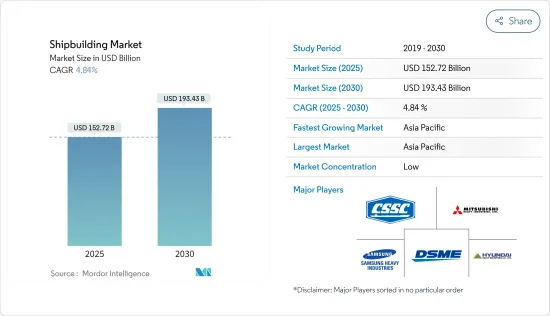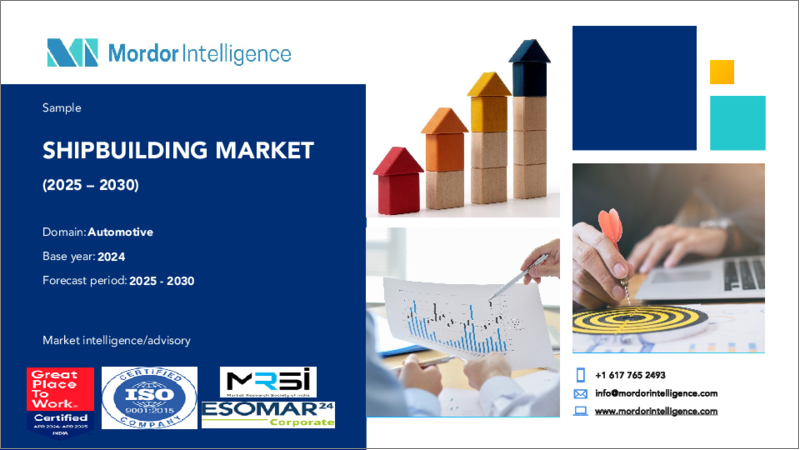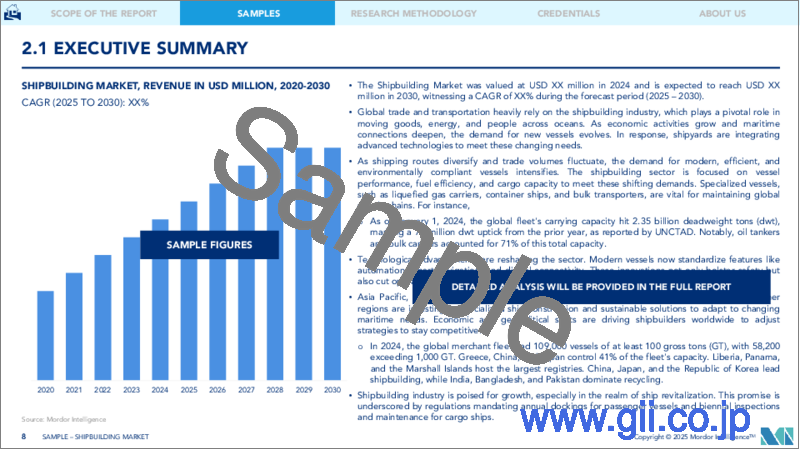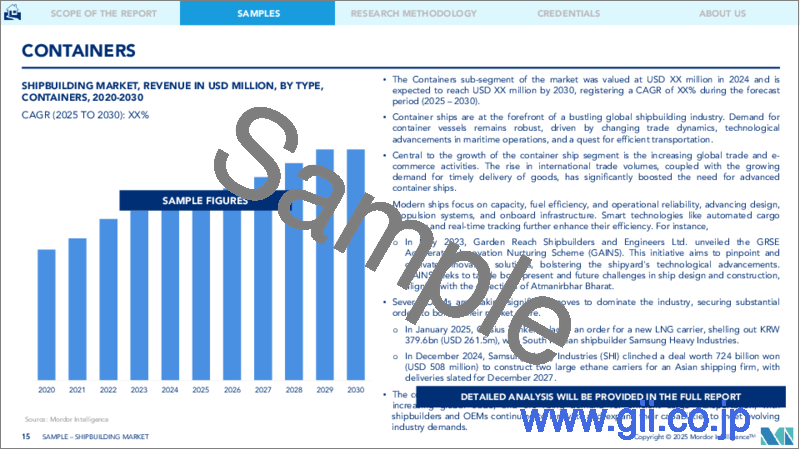|
|
市場調査レポート
商品コード
1690085
造船-市場シェア分析、産業動向・統計、成長予測(2025年~2030年)Shipbuilding - Market Share Analysis, Industry Trends & Statistics, Growth Forecasts (2025 - 2030) |
||||||
カスタマイズ可能
適宜更新あり
|
|||||||
| 造船-市場シェア分析、産業動向・統計、成長予測(2025年~2030年) |
|
出版日: 2025年03月18日
発行: Mordor Intelligence
ページ情報: 英文 70 Pages
納期: 2~3営業日
|
全表示
- 概要
- 目次
造船市場規模は2025年に1,527億2,000万米ドルと推定され、予測期間中(2025~2030年)のCAGRは4.84%で、2030年には1,934億3,000万米ドルに達すると予測されます。

長期的には、海上貿易の増加や経済成長、エネルギー消費の増加、エコフレンドリー船舶や海運サービスへの需要、造船におけるロボット技術の登場などにより、造船市場は予測期間中に成長すると予想されます。
造船市場は厳しい局面を迎えているが、主要市場は依然として市場を成長方向へ向かわせようと努力しています。韓国では、政府が造船業を支援するために様々な取り組みを行っており、国内の企業の受注が増加しています。
近年、造船産業では3Dプリンティング技術の導入が大きな流れとなっています。造船を含め、製造やエンジニアリングに関連するあらゆる産業が、アディティブ・マニュファクチャリングとしても知られる3Dプリンティングを導入しています。造船産業の企業は、他の市場参入企業と協力して、3Dプリンティングなどの最先端の製造技術を取り入れ、製造能力を向上させています。
さらに、東アジア地域が造船を支配しており、中国、日本、韓国がそれぞれ1位と2位を占めています。2022年には、中国が造船受注の半分以上を獲得し、世界の造船大国としての地位を確立しました。東南アジアも同様に船舶解体に集中しており、バングラデシュ、インド、パキスタンが世界の船舶解体の90%近くを占めています。
造船市場の動向
各国間の貿易と海軍活動の増加が市場を牽引
貿易の成長はここ数十年の世界経済の特徴の一つであり、海上輸送は世界貿易の基幹です。海上貿易は主に造船市場に影響を与えます。サプライチェーンの拡大と新市場の開拓により、海上輸送は世界各国の経済開拓の触媒となっています。世界の貨物のほぼ90%は海上輸送です。その結果、各国は船舶に大きく依存し、それが造船市場をさらに加速させています。
中国、日本、韓国は造船活動の約85%を占めています。中国、韓国、日本は引き続き海運船舶供給の大部分を占め、2022年には市場の94%を占めます。過去1年間の造船量は中国で15.5%、韓国で8.3%増加したが、日本では16.4%減少しました。2022年6月、韓国は代替燃料船の70%を、中国は26%を、欧州は58%を、日本は17%を発注しました。韓国はガス運搬船の64%、石油タンカーの42%を占め、日本はケミカルタンカーの45%を占めました。貨物船は貿易活動に使用される最も好ましい船舶です。
海上輸送の需要は年々増加しており、それに伴い輸出入の数も世界中で増加しています。グローバリゼーションが多くの経済の中心部に根付き、国際的な商品取引の可能性が高まり、さまざまな価格帯で入手可能な商品の優れた範囲が提供されています。
2022年1月1日時点の船舶保有国トップ3には、載貨重量トン数と商業価値の両方で、中国と日本というアジアの2カ国が含まれています。中国は、2022年1月1日までの12ヶ月間に、船舶保有国上位25カ国の中で2番目にトン数が増加した(13%)。
カナダ政府は海軍向け船舶の契約を導入しており、これが同国における防衛艦船の需要を生み出す可能性があります。政府の大型艦船群建造計画を支援するため、政府はカナダの2つの造船所、すなわちアービング造船(ハリファックス)とシースパンのバンクーバー造船所(バンクーバー)と、カナダ海軍向けの戦闘艦艇と非戦闘艦艇、ならびにカナダ沿岸警備隊向けの非戦闘艦艇の建造に関する長期戦略契約を締結しました。
これに関して、2023年1月、アービング造船と連邦政府は、カナダ沿岸警備隊向けに北極・海上パトロール艦2隻を追加建造する16億米ドルの契約に合意しました。
こうした事例が造船産業の成長を後押ししています。
アジア太平洋が市場を独占する見込み
造船部門は、製造業を営む国々のGDPに大きく貢献しています。インドには現在28の造船所があり、そのうち6つは中央公共部門が、2つは州政府が、20は非公開会社が経営しています。インド輸出団体連合会(FIEO)も造船業改革を提唱しています。
中国、日本、韓国が造船活動の約85%を占めています。中国、韓国、日本は引き続き海運船舶供給の大部分を占め、2022年には市場の94%を占めます。2022年6月、韓国は代替燃料対応船舶の70%を発注し、中国は26%、欧州は58%、日本は17%を発注しました。韓国はガス運搬船の64%、石油タンカーの42%を占め、日本は化学タンカーの45%を占めています。貨物船は貿易活動に使用される最も好ましい船舶です。
インドの造船産業は、Atmanirbhar Bharatの使命を強化する可能性を秘めています。それは、鉄鋼、アルミニウム、電気機械設備など、他のほとんどの主要産業と直接的・間接的に広範なつながりがあること、また、経済のインフラやサービス部門に依存していることによる。2023年8月にJNPAで取り扱われたインドの総輸送量は734万トンで、2022年8月の639万トンを14.75%上回りました。2022年8月のコンテナ貨物581万トン、バルク貨物5,900トンに対し、8月のコンテナ貨物664万トン、バルク貨物6,900トンです。
商業価値の面では、フリート所有と登録の順位はトン数よりも不安定です。中国が1.1%ポイント増加し、スイス、香港、中国、韓国が続きました。
ベトナム産業貿易省は、アジア域内航路のサプライチェーン問題を緩和し、貿易業者の負担を軽減することを目的としたいくつかの措置を提案しました。これには、新造船への外国投資を奨励する税制優遇措置や、重要インフラ整備への民間投資、フリートの更新や沿岸フリート管理プログラムの開発などが含まれます。
さらに、国内では軍艦の開発に関するさまざまな動きがあります。例えば
- 2023年5月、Mitsubishi Heavy Industries(MHI)GroupのMitsubishi Shipbuildingと、今治造船とJapan Marine United Corporationの船舶設計・販売合弁会社であるNihon Shipyard(東京)は、外航液化CO2(LCO2)運搬船開発のための共同研究を開始しました。日本造船は2027年以降の竣工を目指してプロジェクトを推進しています。
このように、上記の要因がこの地域の造船市場の成長をもたらしています。
造船産業概要
造船市場はセグメント化されており、複数の企業が市場で大きなシェアを占めています。同市場における著名な企業には、Mitsubishi Heavy Industries、Hyundai Heavy Industries、China State Ship Building Corporation、DSMEなどがあります。各社は先進的な新製品を開発するため、研究開発に多額の投資を行っています。例えば
- 2023年1月、新興企業のTvastaManufacturing Solutionsは、コルカタ造船所のGarden Reach Shipbuilders and Engineersのために、コルカタ初の3Dプリンティング構造物を建造しました。3Dプリンターによる建造を専門とするTvastaManufacturing Solutionsは、GRSEの技術デモンストレーションとして建造しました。
このような5年間の市場の開拓が市場を牽引するものと期待されます。
その他の特典
- エクセル形式の市場予測(ME)シート
- 3ヶ月間のアナリストサポート
目次
第1章 イントロダクション
- 調査の前提条件
- 調査範囲
第2章 調査手法
第3章 エグゼクティブサマリー
第4章 市場力学
- 市場の促進要因
- 各国間の貿易活動の活発化が市場を牽引
- 市場抑制要因
- 輸送・在庫コストの変動が市場成長の妨げになる可能性
- 産業の魅力-ポーターのファイブフォース分析
- 供給企業の交渉力
- 買い手/消費者の交渉力
- 新規参入業者の脅威
- 代替品の脅威
- 競争企業間の敵対関係の強さ
第5章 市場セグメンテーション
- 船種
- 船舶
- コンテナ
- 旅客船
- その他
- エンドユーザー
- 輸送会社
- 軍関係者
- その他
- 地域
- 北米
- 米国
- カナダ
- その他の北米
- 欧州
- ドイツ
- 英国
- フランス
- その他の欧州
- アジア太平洋
- 中国
- インド
- 日本
- 韓国
- その他のアジア太平洋
- その他
- ブラジル
- メキシコ
- アラブ首長国連邦
- その他の国
- 北米
第6章 競合情勢
- ベンダー市場シェア
- 企業プロファイル
- China State Shipbuilding Corporation
- Mitsubishi Heavy Industries Ltd
- Samsung Heavy Industries
- Daewoo Shipbuilding Marine Engineering Co. Ltd
- Hyundai Heavy Industries Co. Ltd
- Sumitomo Heavy Industries
- Hanjin Heavy Industries and Construction Co.
- Yangzijiang Shipbuilding Ltd
- United Shipbuilding Corporation
- STX Group
第7章 市場機会と今後の動向
The Shipbuilding Market size is estimated at USD 152.72 billion in 2025, and is expected to reach USD 193.43 billion by 2030, at a CAGR of 4.84% during the forecast period (2025-2030).

Over the long term, the shipbuilding market is expected to grow over the forecast period due to increasing seaborne trade and economic growth, rising energy consumption, the demand for eco-friendly ships and shipping services, and the advent of robotics in shipbuilding.
Though the shipbuilding market is facing a tough time, the major markets are still working and trying to turn the market toward a growth direction. In Korea, the government is taking various initiatives to support the shipbuilding industry, as the companies in the nation receive a greater number of orders.
In recent years, the shipbuilding industry saw a significant trend toward the adoption of 3D printing technologies. Every industry related to manufacturing and engineering, including shipbuilding, is embracing 3D printing, also known as additive manufacturing. Companies in the shipbuilding industry are working together with other market participants to embrace cutting-edge manufacturing technologies, such as 3D printing, to improve their manufacturing capacities.
Further, the East Asian region dominates shipbuilding, with China, Japan, and South Korea ranking first and second, respectively. In 2022, China received more than half of all shipbuilding orders, establishing it as a global shipbuilding powerhouse. Southeast Asia is similarly concentrated in ship destruction, with Bangladesh, India, and Pakistan accounting for nearly 90% of global ship scrapping activities.
Shipbuilding Market Trends
Increasing Trade and Naval Activities Between Countries to Drive the Market
Trade growth is one of the hallmarks of the global economy in recent decades, and maritime transport is the backbone of global trade. Maritime trades primarily influence the shipbuilding market. With the extended supply chains and opened new markets, maritime transport is a catalyst for the economic development of nations worldwide. Almost 90% of global freight is seaborne. As a result, countries heavily rely on ships, which further accelerates the shipbuilding market.
China, Japan, and South Korea represented approximately 85% of the shipbuilding activity. China, the Republic of Korea, and Japan continue to dominate maritime ship supply, accounting for 94% of the market in 2022. Shipbuilding increased by 15.5% in China and 8.3% in the Republic of Korea over the past year but declined by 16.4% in Japan. In June 2022, the Republic of Korea ordered 70% of the alternative fuel-capable ships, China ordered 26%, Europe ordered 58%, and Japan ordered 17%. South Korea accounted for 64% of gas carriers and 42% of oil tankers, and Japan accounted for 45% of chemical tankers. Cargos are the most preferred marine vessels used for trading activities.
There is an increase in demand for maritime transport over the years, which caused a subsequent rise in the number of imports and exports across the world. With globalization taking root in the heart of many economies, there are growing possibilities of internationally trading goods, providing a superior range of available products at different price points.
The top three ship-owning countries in terms of both dead-weight tonnage and commercial value as of 1 January 2022 included two Asian countries, namely China and Japan. China had the second-highest increase in tonnage (13%) among the top 25 ship-owning countries in the 12 months to 1 January 2022.
The Canadian government is introducing contracts for ships for the navy, which may generate the demand for defense ships in the country. To support the government's plans to build a large vessel fleet, the government signed a long-term strategic agreement with two Canadian shipyards, namely, Irving Shipbuilding Inc. (Halifax) and Seaspan's Vancouver Shipyards Co. Ltd (Vancouver), for the construction of combat and non-combat naval vessels for the Royal Canadian Navy and non-combat vessels for the Canadian Coast Guard.
In this regard, in January 2023, Irving Shipbuilding and the federal government agreed to a USD 1.6 billion contract to build two additional Arctic and offshore patrol ships for the Canadian Coast Guard.
Such instances are aiding the growth of the shipbuilding industry.
Asia-Pacific is Expected to Dominate the Market
The shipbuilding sector is one of the major contributors to the GDP of the countries in the manufacturing sector. India currently includes 28 shipyards, six of which are run by the Central Public Sector, two by state governments, and 20 by private companies. The Federation of Indian Export Organizations (FIEO) is also advocating for shipbuilding industry reforms.
China, Japan, and South Korea represented approximately 85% of the shipbuilding activity. China, the Republic of Korea, and Japan continue to dominate maritime ship supply, accounting for 94% of the market in 2022. In June 2022, the Republic of Korea ordered 70% of the alternative fuel-capable ships, China ordered 26%, Europe ordered 58%, and Japan ordered 17%. South Korea accounted for 64% of gas carriers and 42% of oil tankers, and Japan accounted for 45% of chemical tankers. Cargos are the most preferred marine vessels used for trading activities.
The shipbuilding industry in India holds the potential to strengthen the mission of an Atmanirbhar Bharat. It is due to its extensive direct and indirect links with most other leading industries such as steel, aluminum, electrical machinery and equipment, and so on, as well as its reliance on infrastructure and services sectors of the economy. The total traffic handled at JNPA in India during August 2023 is 7.34 million tonnes, which is 14.75% higher than 6.39 million tonnes in August 2022. August's traffic includes 6.64 million tonnes of container traffic and 0.69 million tonnes of bulk cargo as against 5.81 million tonnes of container traffic and 0.59 million tonnes of bulk traffic in the corresponding month of 2022.
In terms of commercial value, the ranking of fleet ownership and registration is more volatile than in terms of tonnage. China increased its share the most by 1.1% points, followed by Switzerland, Hong Kong, China, and the Republic of Korea, all of which contain a higher proportion of container ships in their fleets.
The Ministry of Industry and Trade in Vietnam proposed several measures aimed at easing supply chain issues along intra-Asian routes and reducing the burden on traders. These included tax breaks to encourage foreign investment in new ships and private-sector investment in critical infrastructure upgrades, as well as fleet renewal and the development of a coastal fleet management program.
Further, there are various developments in the country concerning the development of warships in the country. For instance,
- In May 2023, Mitsubishi Shipbuilding, a part of Mitsubishi Heavy Industries (MHI) Group and Nihon Shipyard Co., Ltd., a Tokyo-based joint venture for ship design and sales between Imabari Shipbuilding Co., Ltd., and Japan Marine United Corporation, started joint study for the development of an ocean-going liquified CO2 (LCO2) carrier. Nihon Shipyard is pursuing this project to complete the construction of the vessel from 2027 onwards.
Thus, the factors above are responsible for the growth of the Shipbuilding market in the region.
Shipbuilding Industry Overview
The shipbuilding market is fragmented, with several players accounting for significant amounts of shares in the market. Some of the prominent companies in the market are Mitsubishi Heavy Industries, Hyundai Heavy Industries, China State Ship Building Corporation, DSME, and others. Companies are investing heavily in research and development for the innovation of new and advanced products. For instance:
- In January 2023, A start-up, TvastaManufacturing Solutions, built Kolkota's first 3D printed structure for Garden Reach Shipbuilders and Engineers at the Kolkata shipyard. Tvasta Manufacturing Solutions, which specializes in 3D printing construction, built the structure as a technology demonstrator for GRSE.
Such developments over the five years are expected to drive the market.
Additional Benefits:
- The market estimate (ME) sheet in Excel format
- 3 months of analyst support
TABLE OF CONTENTS
1 INTRODUCTION
- 1.1 Study Assumptions
- 1.2 Scope of the Study
2 RESEARCH METHODOLOGY
3 EXECUTIVE SUMMARY
4 MARKET DYNAMICS
- 4.1 Market Drivers
- 4.1.1 Increasing Trade Activities Between Countries to Drive the Market
- 4.2 Market Restraints
- 4.2.1 Fluctuation in Transportation and Inventory Cost May Hamper the Growth of the Market
- 4.3 Industry Attractiveness - Porter's Five Forces Analysis
- 4.3.1 Bargaining Power of Suppliers
- 4.3.2 Bargaining Power of Buyers/Consumers
- 4.3.3 Threat of New Entrants
- 4.3.4 Threat of Substitute Products
- 4.3.5 Intensity of Competitive Rivalry
5 MARKET SEGMENTATION (Market Size in USD)
- 5.1 Type
- 5.1.1 Vessel
- 5.1.2 Container
- 5.1.3 Passenger
- 5.1.4 Other Types
- 5.2 End User
- 5.2.1 Transport Companies
- 5.2.2 Military
- 5.2.3 Other End Users
- 5.3 Geography
- 5.3.1 North America
- 5.3.1.1 United States
- 5.3.1.2 Canada
- 5.3.1.3 Rest of North America
- 5.3.2 Europe
- 5.3.2.1 Germany
- 5.3.2.2 United Kingdom
- 5.3.2.3 France
- 5.3.2.4 Rest of Europe
- 5.3.3 Asia-Pacific
- 5.3.3.1 China
- 5.3.3.2 India
- 5.3.3.3 Japan
- 5.3.3.4 South Korea
- 5.3.3.5 Rest of Asia-Pacific
- 5.3.4 Rest of the World
- 5.3.4.1 Brazil
- 5.3.4.2 Mexico
- 5.3.4.3 United Arab Emirates
- 5.3.4.4 Other Countries
- 5.3.1 North America
6 COMPETITIVE LANDSCAPE
- 6.1 Vendor Market Share
- 6.2 Company Profiles
- 6.2.1 China State Shipbuilding Corporation
- 6.2.2 Mitsubishi Heavy Industries Ltd
- 6.2.3 Samsung Heavy Industries
- 6.2.4 Daewoo Shipbuilding Marine Engineering Co. Ltd
- 6.2.5 Hyundai Heavy Industries Co. Ltd
- 6.2.6 Sumitomo Heavy Industries
- 6.2.7 Hanjin Heavy Industries and Construction Co.
- 6.2.8 Yangzijiang Shipbuilding Ltd
- 6.2.9 United Shipbuilding Corporation
- 6.2.10 STX Group





